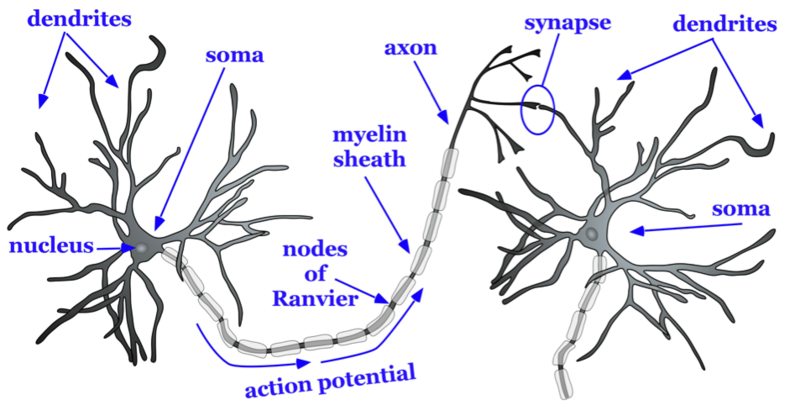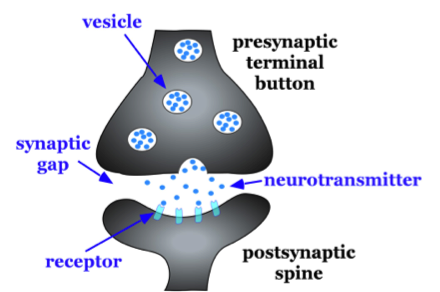- Describe the central nervous system
- Describe the structure and function of a neuron
- Describe how neurons communicate with each other
- Understand how neurotransmitters work and how drugs affect neurotransmitter systems
Neuron Structure and Function
If we were able to magnify a view of individual neurons we would see that they are cells made from distinct parts. The three main components of a neuron are the dendrites, the soma, and the axon. Neurons communicate with one another by receiving information through the dendrites, which act as an antenna. When the dendrites channel this information to the soma, or cell body, it builds up as an electrochemical signal. This electrical part of the signal, called an action potential shoots down the axon, a long tail that leads away from the soma and toward the next neuron. When people talk about “nerves” in the nervous system, it typically refers to bundles of axons that form long neural wires along which electrical signals can travel. Cell-to-cell communication is helped by the fact that the axon is covered by a myelin sheath—a layer of fatty cells that allow the signal to travel very rapidly from neuron to neuron (Kandel, Schwartz & Jessell, 2000)

You can view the transcript for “The Parts of the Neuron” here (opens in new window).
If we were to zoom in still further we could take a closer look at the synapse, the space between neurons. Here, we would see that there is a space between neurons, called the synaptic gap. To give you a sense of scale we can compare the synaptic gap to the thickness of a dime, the thinnest of all American coins (about 1.35 mm). You could stack approximately 70,000 synaptic gaps in the thickness of a single coin!
Neuron Communication
As the action potential, the electrical signal reaches the end of the axon, tiny packets of chemicals, called neurotransmitters, are released. This is the chemical part of the electro-chemical signal. These neurotransmitters are the chemical signals that travel from one neuron to another, enabling them to communicate with one another. There are many different types of neurotransmitters and each has a specialized function. For example, serotonin affects sleep, hunger and mood. Dopamine is associated with attention, learning and pleasure (Kandel & Schwartz, 1982).

Watch the following video to see how neurons communicate within the body.
You can view the transcript for “How do nerves work? – Elliot Krane” here (opens in new window).
Watch the following video to see how neurons communicate within the body.
You can view the transcript for “The Chemical Mind: Crash Course Psychology #3” here (opens in new window)